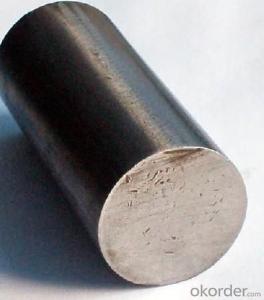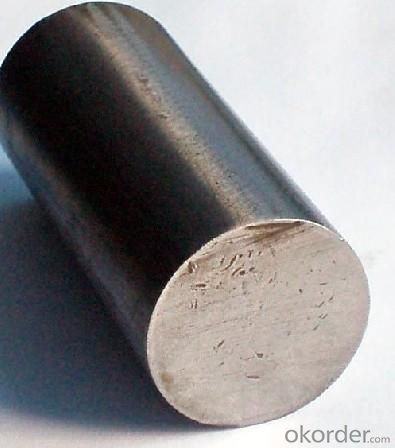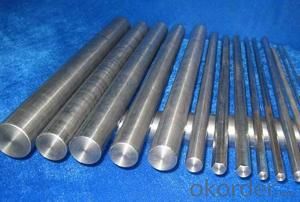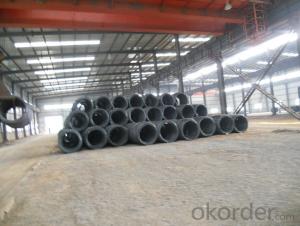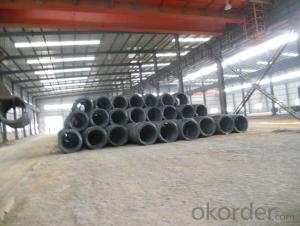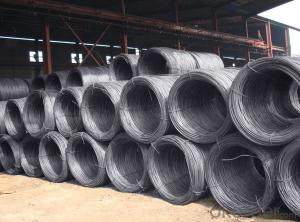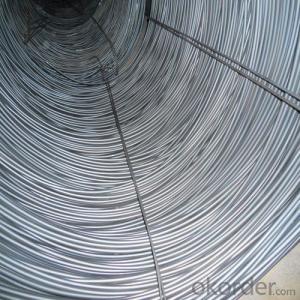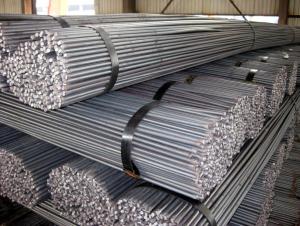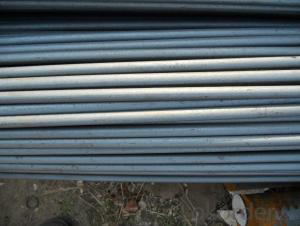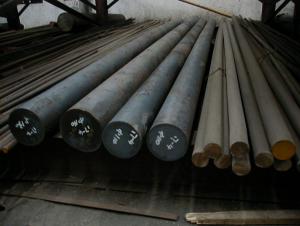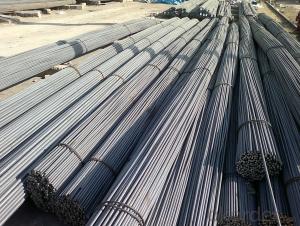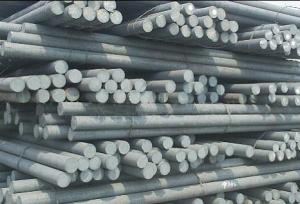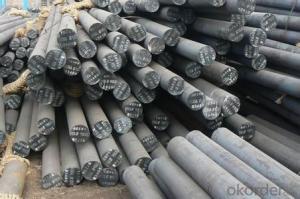Wire Rod Hot Rolled SAE1008 SAE1006 Added Boron and added chrome
- Loading Port:
- China Main Port
- Payment Terms:
- TT or LC
- Min Order Qty:
- -
- Supply Capability:
- -
OKorder Service Pledge
OKorder Financial Service
You Might Also Like
Product Description:
OKorder is offering high quality Wire Rod Hot Rolled SAE1008 SAE1006at great prices with worldwide shipping. Our supplier is a world-class manufacturer of steel, with our products utilized the world over. OKorder annually supplies products to European, North American and Asian markets. We provide quotations within 24 hours of receiving an inquiry and guarantee competitive prices.
Product Applications:
After hot-rolled the products shaped into coil and delivery as finished product, including round, square, rectangular, hexagonal and so on. Since most of the products are round, it is generally called wire rod. Carbon steel wire rod is widely used in construction and manufacturing. Carbon steel wire rod is mainly used for reinforcement of reinforced concrete and welded structure or reprocessed (roberts , nail, etc.) materials, especially used to produce wire drawing, welding electrode, nails, spring, electronic, precise machinery parts and so on.
Product Advantages:
OKorder's Wire Rod Hot Rolled SAE1008 SAE1006are durable, strong, and resist corrosion.
Main Product Features:
· Premium quality
· Prompt delivery & seaworthy packing (30 days after receiving deposit)
· Corrosion resistance
· Can be recycled and reused
· Mill test certification
· Professional Service
· Competitive pricing
Product Specifications:
Manufacture: Hot rolled
Grade: SAE1008 SAE 1006
Certificates: ISO, SGS, BV, CIQ
Diameter: 5.5mm, 6.5mm, 7mm,8mm,9mm,10mm,12mm,14mm, as per customer request
Packaging: Export packing, nude packing, bundled
Grade | Chemical Composition (%) | |||||
C | Mn | S | P | Si | B | |
SAE1008B | 0.10max | 0.32max | 0.045max | 0.040max | 0.30max | 0.0008min |
Mechanical properties | ||||||
Yield strength(N/mm2) | Tensile strength(N/mm2) | Elongation (%) | ||||
≥195 | 350-380 | ≥32 | ||||
FAQ:
Q1: Why buy Materials & Equipment from OKorder.com?
A1: All products offered byOKorder.com are carefully selected from China's most reliable manufacturing enterprises. Through its ISO certifications, OKorder.com adheres to the highest standards and a commitment to supply chain safety and customer satisfaction.
Q2: How do we guarantee the quality of our products?
A2: We have established an advanced quality management system which conducts strict quality tests at every step, from raw materials to the final product. At the same time, we provide extensive follow-up service assurances as required.
Q3: How soon can we receive the product after purchase?
A3: Within three days of placing an order, we will begin production. The specific shipping date is dependent upon international and government factors, but is typically 7 to 10 workdays.

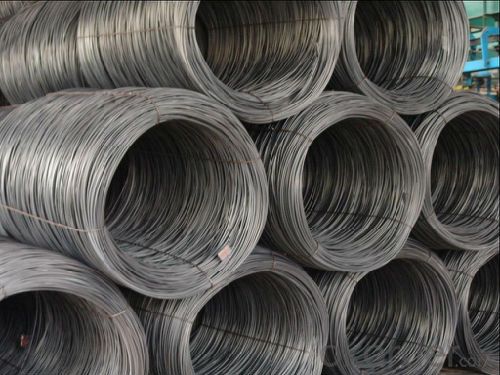
- Q: What are the weight calculations for steel round bars?
- The weight calculations for steel round bars can be determined using a straightforward formula. The weight of a steel round bar can be calculated by multiplying the square of the diameter in millimeters by the length in meters and then multiplying the result by the specific weight of steel, which is typically around 7.85 grams per cubic centimeter. The formula for calculating the weight of a steel round bar is as follows: Weight = (Diameter^2 x Length x Specific Weight of Steel) / 1000 Where: - Diameter is the diameter of the round bar in millimeters - Length is the length of the round bar in meters - Specific Weight of Steel is the density of steel, which is usually 7.85 grams per cubic centimeter - 1000 is used to convert the weight from grams to kilograms It is important to note that this formula assumes the round bar is made of pure steel and does not account for any variations in the specific weight of different steel alloys. Additionally, it is crucial to use consistent units throughout the calculation, either millimeters or meters, to obtain accurate results.
- Q: Can steel round bars be used in the manufacturing of firearms?
- Indeed, the utilization of steel round bars is feasible in the manufacturing process of firearms. Due to its exceptional strength and durability, steel is frequently employed as a primary material in the construction of firearms. These round bars can be expertly machined and formed into diverse components of a firearm, including barrels, bolts, receivers, and triggers. The hardness and caliber of the steel implemented in the manufacturing of firearms play a vital role in guaranteeing the dependability and safety of the weapon. Thus, it is commonplace to employ steel round bars that satisfy the requisite specifications and standards in the production of firearms.
- Q: How do steel round bars perform under cyclic loading?
- Steel round bars exhibit excellent performance under cyclic loading due to their high strength and ductility, enabling them to withstand significant stress without deformation or failure. The fatigue characteristics of steel round bars are influenced by various factors, including material composition, heat treatment, and surface finish. Bars with higher tensile strength and hardness demonstrate superior fatigue resistance, enabling them to endure higher stress levels before failure. Cyclic loading subjects steel round bars to stress cycles that induce alternating compression and tension forces. These cycles can initiate and propagate cracks, ultimately leading to failure. However, steel's inherent ductility allows it to absorb energy and redistribute stress, thereby mitigating crack propagation and extending the bar's fatigue life. Fatigue strength assessments typically involve subjecting steel round bars to a specified number of stress cycles until failure occurs. These tests yield valuable information on the bar's endurance limit and fatigue life under different loading conditions. Various techniques, such as shot peening, surface coating, and induction of residual stress, can be employed to enhance the fatigue performance of steel round bars. These techniques introduce compressive stress on the bar's surface, inhibiting crack initiation and propagation, thereby improving fatigue resistance. In summary, steel round bars are reliable and durable when subjected to cyclic loading, making them suitable for applications involving repeated or fluctuating stresses, such as structural components, automotive parts, and machinery components. However, careful consideration of loading conditions, material properties, and design criteria is necessary to ensure optimal performance and longevity when selecting steel round bars.
- Q: What is the difference between 40Cr round steel and 40Cr steel forgings?
- Generally speaking the 40Cr steel is a kind of hot rolled steel (rarely cold). The need for heating the material before hot rolling process is or rolled, usually heated to above the recrystallization temperature, then condensation formed after the bar, of course I say is very simple, there are many steps.
- Q: What are the advantages of using alloy steel round bars?
- There are several advantages of using alloy steel round bars. Firstly, alloy steel round bars offer superior strength and durability compared to regular steel bars. This makes them ideal for applications where high strength and toughness are required, such as in construction, automotive, and aerospace industries. The alloying elements in these bars enhance their mechanical properties, making them more resistant to wear, impact, and corrosion. Additionally, alloy steel round bars have excellent heat resistance. They can withstand high temperatures without losing their strength, making them suitable for use in high-temperature environments like furnaces, boilers, and heat exchangers. This property allows for extended service life and reduces the need for frequent replacements. Another advantage of using alloy steel round bars is their versatility. These bars can be easily machined, forged, or welded, allowing for flexibility in design and manufacturing processes. They can be customized to meet specific requirements, making them suitable for various applications. Furthermore, alloy steel round bars have good dimensional stability. They maintain their shape and size even under extreme conditions, ensuring precise and accurate performance. This property is particularly important in applications where tight tolerances are required, such as in precision engineering and manufacturing industries. Lastly, alloy steel round bars are cost-effective in the long run. Although they may have a higher initial cost compared to regular steel bars, their enhanced properties and extended service life result in reduced maintenance and replacement costs. This makes them a more economical choice in the long term. In conclusion, the advantages of using alloy steel round bars include superior strength and durability, excellent heat resistance, versatility in machining and fabrication, good dimensional stability, and long-term cost-effectiveness. These benefits make them a preferred choice in various industries where high-performance materials are required.
- Q: What is the maximum length of a steel round bar that can be produced?
- The maximum length of a steel round bar that can be produced depends on various factors such as the manufacturing process, the size and capacity of the equipment, and the logistical constraints involved. In general, steel round bars can be produced in lengths ranging from a few feet to several hundred feet. However, it is important to note that longer lengths may come with certain limitations or considerations. For instance, in hot rolling mills, the maximum length of a steel round bar is often determined by the size and capacity of the rolling mill itself. The length of the bar should be within the range that can be effectively rolled and processed by the machinery. Additionally, transportation and handling logistics can also impose constraints on the maximum length of a steel bar. Longer bars may require specialized equipment or careful planning to ensure safe and efficient movement. Therefore, it is crucial to consider the specific production capabilities and constraints of the steel manufacturer or supplier when determining the maximum length of a steel round bar that can be produced.
- Q: What are the different testing methods used for steel round bars?
- There are several testing methods used for steel round bars to ensure their quality and suitability for various applications. These methods include: 1. Visual Inspection: This is the initial step of testing, where the bars are visually examined for any visible defects, such as cracks, surface irregularities, or improper dimensions. 2. Dimensional checks: Steel round bars undergo dimensional checks to verify their diameter, length, and straightness. Precise measurements are essential to meet the specified requirements. 3. Ultrasonic Testing: Ultrasonic waves are passed through the round bars to detect internal defects, such as cracks, voids, or inclusions. This method helps identify potential weaknesses that may affect the structural integrity of the bars. 4. Magnetic Particle Inspection: This method uses a magnetic field and magnetic particles to detect surface and near-surface defects like cracks, seams, or laps. It is particularly useful in ferromagnetic materials such as steel. 5. Dye Penetrant Inspection: This technique involves applying a colored dye to the surface of the round bars and then wiping it off. The dye penetrates into any surface cracks or defects, making them visible under ultraviolet light. 6. Hardness Testing: This test measures the hardness of the steel round bars using methods like Rockwell or Brinell scales. It helps determine the material's ability to withstand external forces and ensures it meets the required hardness specifications. 7. Tensile Testing: Tensile strength testing is conducted to measure the maximum load a steel round bar can bear before it breaks. This test helps evaluate the material's strength and ductility. 8. Chemical Analysis: Chemical analysis is performed to determine the composition of the steel round bars, including the presence of elements like carbon, manganese, sulfur, phosphorus, and others. It ensures that the steel meets the required chemical composition standards. These testing methods are crucial in ensuring the quality, reliability, and compliance of steel round bars with industry standards and customer requirements. It is essential to perform a combination of these tests to ensure the overall quality and performance of the steel round bars in different applications.
- Q: Are lightning checks required for galvanized steel, flat steel and round steel?
- When you buy hot galvanized round steel and flat steel, please provide inspection documents. In addition, in the procurement of materials must be explained that hot galvanizing, or else the business to provide you with cold plating will not work; there is a certain price gap between the two.
- Q: 12 of the diameter of the round steel can be M12 out of the thread is not
- It depends on your material straight straight, generally should be right, you check the metric thread specification table, there is large size can be much, I think you are a little round a little better, so that you may get the car, do not appear to have a side material shortage phenomenon
- Q: How do steel round bars compare to wrought iron bars?
- Steel round bars and wrought iron bars have several differences that set them apart. Firstly, steel round bars are made from an alloy of iron and carbon, whereas wrought iron bars are composed of pure iron with a low carbon content. This difference in composition leads to varying properties. Steel round bars are known for their strength and durability, making them suitable for a wide range of applications, including construction, manufacturing, and engineering. On the other hand, wrought iron bars are softer and more malleable, allowing them to be easily shaped and formed into intricate designs. This characteristic makes wrought iron bars popular in decorative applications such as gates, fences, and ornamental pieces. Another difference lies in their manufacturing processes. Steel round bars are typically produced through hot rolling, which involves heating the steel billet and passing it through a series of rollers to shape it into the desired round bar form. In contrast, wrought iron bars are made through a labor-intensive process called blacksmithing. This involves heating the iron and repeatedly hammering it to remove impurities and create a fibrous structure, resulting in its characteristic grainy appearance. In terms of cost, steel round bars are generally more affordable compared to wrought iron bars. The manufacturing process for steel is more streamlined and efficient, leading to lower production costs. Wrought iron bars, on the other hand, require more time and labor, making them more expensive. Finally, when it comes to corrosion resistance, steel round bars have an advantage. Steel can be further alloyed with elements such as chromium, nickel, and molybdenum to enhance its resistance to rust and corrosion. This makes steel round bars suitable for outdoor applications where they may be exposed to moisture and harsh environmental conditions. Wrought iron bars, although they possess some level of corrosion resistance, are more prone to rusting and require regular maintenance to prevent deterioration. In conclusion, steel round bars and wrought iron bars differ in terms of composition, strength, manufacturing process, cost, and corrosion resistance. The choice between the two will depend on the specific requirements of the application, with steel round bars being favored for their strength and affordability, while wrought iron bars are often chosen for their malleability and decorative appeal.
Send your message to us
Wire Rod Hot Rolled SAE1008 SAE1006 Added Boron and added chrome
- Loading Port:
- China Main Port
- Payment Terms:
- TT or LC
- Min Order Qty:
- -
- Supply Capability:
- -
OKorder Service Pledge
OKorder Financial Service
Similar products
Hot products
Hot Searches
Related keywords
